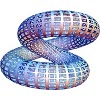Topology and Geometric Group Theory Seminar
A spine for a group G acting on a space E is a subset onto which there is a G-equivariant deformation retraction of E. For the space of lattices of covolume 1 in R^n, the action of SL_n(Z) admits a spine of minimal dimension called the well-rounded retract, consisting of the lattices whose shortest nonzero vectors span R^n. Whether a spine of dimension 4g-5 exists for the action of the mapping class group on the Teichmuller space T_g of closed hyperbolic surfaces of genus g is an open problem. In a 1985 preprint, Thurston claimed to prove that the set X_g of surfaces whose systoles (the shortest closed geodesics) fill (cut the surfaces into polygons) is a spine for T_g. However, his argument had serious gaps as pointed out by Ji in 2014. Whether or not X_g is a spine, its dimension is strictly larger than 4g-5 in certain genera. In this talk, I will give a recipe for constructing hyperbolic surfaces out of semi-regular polygons in such a way that 1) the systoles cut out exactly these polygons and 2) there are relatively few systoles. The dimension result then follows by deforming such surfaces. The same construction shows that the set of surfaces whose systoles generate a finite-index subgroup in homology (a closer analogue of the well-rounded retract) does not contain any spine.
